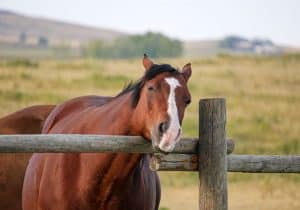Equine Guttural Pouch Infections

The horse’s guttural pouches are a pair of air-filled sacs in the throatlatch region. They are an extension of the eustachian tubes, which in humans are tiny tubes connecting the middle ear to the back of the throat. In horses, guttural pouches are lined with a thin membrane and surrounded by several very important structures, including the internal carotid artery and cranial nerves that control facial expression, swallowing, and upper respiratory tract function. A long, thin stylohyoid bone divides each guttural pouch into lateral and medial compartments. These pouches can be the source of various bacterial and fungal infections.
Guttural pouch empyema, or pus in the guttural pouches, often stems from streptococcal infections. In a horse infected with Streptococcus equi subspecies equi (strangles), for instance, an abscessed retropharyngeal lymph node can rupture and drain pus into the adjacent guttural pouches. Pus that remains there for a long period can become inspissated, or dry out, and form chondroids. These firm balls of pus can be difficult to remove and can cause a horse that appears healthy to continually shed infectious bacteria.
Systemic signs of guttural pouch empyema might include fever, depression, nasal discharge, and painful throatlatch swelling. Occasionally, inflammation and infection within the pouches can impair the cranial nerves alongside them, causing difficulty swallowing, noisy breathing, or impaired function of the muscles involved in facial expression.
Horses can have guttural pouch chondroids without obvious signs, and vets might suspect cases after evaluating a farm’s history of strangles outbreaks. Veterinarians typically diagnose guttural pouch empyema and chondroids with endoscopy, inserting a thin, flexible camera into the guttural pouches via the nasal cavity. Radiographs can also reveal fluid or chondroids in the guttural pouches.
Prognosis for guttural pouch empyema is good with medical treatment, which often involves daily lavage (flushing) of the infected pouches and antibiotic therapy. Systemically ill horses might also require supportive care, including non-steroidal anti-inflammatory drugs to help control fever and malaise. Some horses might need surgery to remove large chondroids, although veterinarians often avoid guttural pouch surgeries if possible due to the risk of damaging the surrounding nerves and subsequent impaired respiratory and swallowing function.
Guttural pouch mycosis, or fungal infection within the guttural pouches, is rare and potentially life-threatening. Fungal plaques tend to form over the internal carotid artery due to the excellent blood flow in this location, though they can also form over the external carotid and the maxillary arteries. Erosion of a fungal plaque through the wall of the internal carotid artery can lead to sudden, severe, and potentially fatal epistaxis (nosebleed).
Clinical signs of guttural pouch mycosis can also be subtle. Veterinarians might suspect the condition in a horse with intermittent and recurrent mild nosebleeds, noisy breathing, or difficulty swallowing. Veterinarians typically diagnose guttural pouch mycosis using endoscopy.
The prognosis for treating horses with guttural pouch mycosis is good if owners catch the condition early and complications do not arise. Horses developing sudden, severe hemorrhage might need blood transfusions. Medical treatment of guttural pouch mycosis, involving lavage and antifungal medication, can be successful but often takes months, and the risk of sudden hemorrhage remains as long as a fungal plaque is active. Surgical treatment involves ligating (tying off) or otherwise occluding blood flow to the segment of internal carotid artery underlying the fungal plaque.
Other guttural pouch conditions can develop in horses, as well. Guttural pouch tympany, or entrapment of excessive air within one or both guttural pouches, can affect young horses. Cancerous masses can form near or within the guttural pouches in any age animal, as can hyoid problems (and resulting enlargement) that impinge on the adjacent cranial nerves, affecting their function.
Discuss any concerning changes in your horse with your veterinarian, who can help determine the best course of action for diagnosis and treatment.
Written by:
Lauren Alderman, DVM, CVA, CVSMT
Related Articles
Stay on top of the most recent Horse Health news with















